What is Mobi.E?
Mobi.E is the cornerstone of Portugal’s electric mobility ecosystem, acting as a central hub that connects operators of charging points (OPCs) and commercializers of electricity for electric mobility (CEMEs). Its primary goal is to enable a competitive, interoperable, and transparent market for electric vehicle (EV) charging services, without imposing a monopoly. Mobi.E plays a crucial role by providing the technological platform and standards necessary for the smooth operation of the EV charging infrastructure.

The Role of Mobi.E as a Hub
Mobi.E functions as a neutral intermediary between CEMEs and OPCs, ensuring that all market players—whether large or small—can participate under equal conditions. This hub-based model fosters healthy competition and innovation by enabling multiple operators to coexist while offering users seamless access to a national charging network.
How Mobi.E Operates as a Hub
-
Interoperability
Mobi.E ensures that any user, regardless of their CEME, can charge their EV at any station operated by any OPC in the network. This interoperability is achieved by providing a unified communication interface that connects CEMEs with OPCs. -
Real-Time Data Handling
Through its platform, Mobi.E collects and processes real-time data on: -
Charging station availability.
- Session status (e.g., duration, energy delivered).
- Pricing information from OPCs.
This data is shared with CEMEs, allowing them to offer real-time services to end users, such as cost simulations, session monitoring, and instant invoicing.
- Billing and Settlement Support
Mobi.E ensures that CEMEs receive accurate data on charging sessions, which is essential for proper billing. It also facilitates the financial settlement between CEMEs and OPCs, ensuring a transparent and smooth process.
Key Principles of Mobi.E
1. No Monopoly – Enabling Competition
Contrary to concerns about monopolistic practices, Mobi.E does not operate any charging stations nor sell electricity directly to users. Instead, it acts as an enabler of competition by:
- Providing a level playing field for all operators.
- Allowing new entrants to join the market easily, fostering innovation and price competitiveness.
- Ensuring transparency in the market by standardizing communication and data exchange.
This open model encourages multiple CEMEs and OPCs to enter the market, offering users more options in terms of pricing, services, and added features.
2. User-Centric Approach
Mobi.E’s model is designed with the user in mind. By ensuring interoperability and access to all charging points through a single contract with any CEME, users benefit from:
- Convenience: No need for multiple contracts or memberships—one CEME provides access to the entire network.
- Transparency: Detailed session information and standardized billing help users understand what they are paying for.
- Flexibility: Users can choose from a variety of CEMEs and OPCs, selecting the services and pricing models that best suit their needs.
3. Standardization and Innovation
Mobi.E provides a standardized infrastructure that simplifies the integration of new operators into the ecosystem. By using open protocols such as OCPI (Open Charge Point Interface), Mobi.E ensures that:
- New OPCs can quickly integrate their charging stations into the network.
- CEMEs can offer advanced services, such as real-time session monitoring, cost simulation, and automated invoicing.
- Users benefit from a consistent experience across different operators and charging stations.
Benefits of Mobi.E’s Model
For Users
- Universal Access: Users can charge their vehicles at any station in the network, regardless of their chosen CEME.
- Choice and Competition: Multiple CEMEs compete to offer the best pricing and services, giving users the freedom to choose.
- Transparency: Users receive clear, standardized invoices and can monitor their sessions in real time.
For Operators (OPCs and CEMEs)
- Ease of Entry: Mobi.E’s standardized platform reduces barriers to entry, allowing new operators to join the market easily.
- Interoperability: Operators can focus on their core business while relying on Mobi.E for interoperability and data exchange.
- Market Growth: By enabling a healthy, competitive market, Mobi.E encourages investment in new charging infrastructure and innovative services.
Mobi.E’s Contribution to the Electric Mobility Sector
Mobi.E’s unique model has made Portugal one of the leading countries in Europe for electric mobility. By fostering competition and ensuring universal access, Mobi.E has accelerated the adoption of electric vehicles and contributed to the country’s decarbonization goals. Key contributions include:
- Promoting a Sustainable Future: By supporting the growth of electric mobility, Mobi.E helps reduce greenhouse gas emissions and dependence on fossil fuels.
- Encouraging Private Investment: The open and competitive market model incentivizes private operators to invest in expanding the charging network.
- Ensuring Market Stability: By acting as a neutral, regulatory-compliant hub, Mobi.E provides stability and trust in the electric mobility ecosystem.
Conclusion
Mobi.E plays a pivotal role in Portugal’s electric mobility sector by acting as a neutral enabler, fostering competition, ensuring interoperability, and promoting transparency. Its hub-based model has created a vibrant, user-centric ecosystem that benefits all stakeholders—from users to operators—while supporting the country’s sustainability goals.
With its continued focus on standardization, innovation, and collaboration, Mobi.E is well-positioned to remain a key driver of electric mobility in Portugal and beyond.